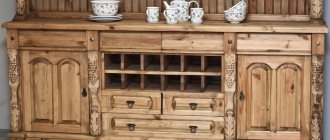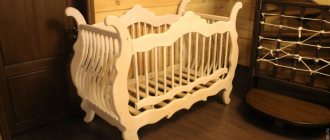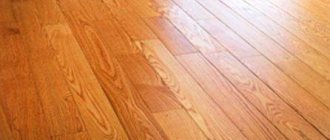What is bog oak
Bog oak is obtained through the process of long-term soaking of wood in a liquid with mineral salts, as a result of which the wood acquires new properties and original color. This process is called mineralization, which takes place in the natural environment. The extraction of such wood is carried out in places where oak groves grew thousands of years ago - often these are swamps. Changes in river beds carried them under water, where the trunks and branches remained intact and acquired incredible strength.
Under the influence of chemicals, the shade of the wood changed - it became darker and more saturated. And the outer layer usually consists of black plates of coal, although the oak was not in fire, but, on the contrary, under water for many centuries.
Application area
Previously, it was often used for interior decoration of palaces and castles.
Nowadays, this type of oak is used for the manufacture of furniture and interior decoration elements (parquet, wall slabs, mosaics).
Souvenirs and jewelry made from this raw material are also exclusive and very interesting. However, finding them is quite difficult, because the manufacture of such products is carried out by a narrow circle of specialists.
Benefits of use
Strength, durability, unique and unusual shade - these are not all the advantages of wood.
The distinctive properties of the material also include:
- Protection from parasites. This wood never harbors parasites. This may be due to the natural chemical treatment that the wood received as a result of the natural staining process.
- Spirituality. There are opinions that oak has unique powerful energy accumulated over thousands of years in unique natural conditions.
- Uniqueness. This natural product has no analogues in terms of aesthetic, religious, cultural and historical parameters. The exclusivity of the products is also due to the fact that there are no two identical trunks in the world.
This high-quality natural product has been valued and in demand at all times, but, unfortunately, oak supplies are limited and cannot be replenished. Although there were attempts at the beginning of the last century.
Why is stained wood popular?
Back in the days when man had just begun to explore the Earth, wood took a reliable ally position as the first available material. No matter how the conditions and the development of scientific and technological progress develop, natural wood has always been in demand, and this trend will remain leading for many centuries to come. Eco-friendly wood is not only safe, but also gives the room a special charm and comfort.
Considering that ordinary wood has become not so interesting in recent years compared to other progressive materials, it’s time to collect laurels for bog wood. In terms of strength characteristics, the material resembles stone due to the properties obtained during the period of being under water.
The color of bog oak is not the main advantage that makes the material preferable in choice. Rested wood is not afraid of cold, moisture, or pests that destroy hectares of forest. Stained material does not require specific care or additional processing. At the same time, it remains the standard of naturalness, environmental friendliness, and purity.
Bog oak in the interior
This wood, despite its rarity, is used quite often in a variety of fields. The rarity and value of the material requires fine manual processing.
The most popular area of application is interior.
This wood is used to make:
- pieces of furniture;
- souvenirs;
- floor finishing materials;
- wall coverings;
- stairs;
- window;
- doors.
Interior items made from this type of wood are characterized by a long service life, and decorative elements are doomed to turn into antique objects.
This material will be an appropriate solution when creating a room design in a Scandinavian style. Furniture made from this wood in the interior is a sign of the prosperity and excellent taste of the owner of the house.
Furniture
Due to its high cost, furniture made of bog oak belongs to the elite category. The high cost is due not only to the limited natural reserves, but also to the complexity of extracting and processing wood - only a fairly experienced craftsman can handle work of this nature. The quality and originality of the product, as a rule, is documented by the seller.
Tables are the most popular category of oak furniture. Made of oak, it is perfect for a kitchen interior in Baroque or classicism style.
In the living room, an interesting solution would be a coffee table. You can put a small table for tea ceremonies in the dining room, and a table for accessories and cosmetics in the bathroom.
In commercial and administrative premises, tables made from this noble raw material are almost universally used. They become a bright and noticeable detail in the director's office or in the conference room.
Advantages and disadvantages
Furniture made from this natural product has a number of advantages:
- attractive and solid appearance;
- environmental friendliness and safety;
- strength and durability;
- a wide variety of options;
- the ability to assemble and disassemble furniture several times.
Products made from this material are truly reliable and strong.
However, they also have a number of disadvantages:
- high price;
- the products are quite heavy;
- difficulty of handling in case of damage.
Experts advise trusting the work of professionals in the manufacture and assembly of furniture, since without some experience it will be quite problematic to “tame” the wood. The talented work of the master will turn tables and other furniture into works of art. Wood that is resistant to any external influences predicts a long life for products made from it. They can serve their owners for many decades, or even hundreds, passing from generation to generation.
Nature-treated oak is a reliable material for creating wood windows with rich texture, excellent thermal and sound insulation, strength and durability. Do not forget that this natural material does not require additional care and is perfectly protected from aggressive environmental influences. In addition, such windows will look organic in almost any interior.
Oak tree - properties and description
The tree itself is a truly powerful and majestic plant. On average, the duration of its development varies between 300-400 years, and there are individual specimens up to 1500 years old. The tree can reach a height of 30-50 m, growing widely in the crown, while having a powerful and strong trunk with a diameter of up to 2 m.
The characteristics, appearance, and properties of oak wood may differ depending on the region of growth, but there are qualities common to all varieties that remain unchanged. This is what attracts home craftsmen and specialists from various industrial sectors; oak wood is used everywhere in various forms.
As for the differences, the following interesting facts can be noted:
- oak wood growing near water bodies has a pleasant pink tint, large layers are clearly visible, and with good elasticity, this material has a very large weight;
- the light yellow tint of the core is characteristic of those trees that grow in wooded areas; the hardness of such material is slightly lower.
Staining oak at home
Modern technologies make it possible to imitate the color of wood. Scientists have achieved that they can recreate the color while maintaining the aesthetics and moisture resistance of the material. The option of making it at home is accessible and simple. Ultimately, you can get a unique oak material with silver veins inside.
In order to obtain such material, you need a special mixture that imitates the shade of natural moraine wood - stain.
The product is applied in two steps: the first layer must be applied to the surface of the wood at a slight angle, applying strokes across the grain, the second - along. To work, you should use a flute - a flat, wide brush specially designed for applying stain and creating natural, imperceptible transitional shades of tone. The soft and resilient bristles of the brush make this tool the best of its kind. Most often, stain is used to treat laminate flooring.
Composition of stain
The composition of the product is simple. Wood impregnation is divided into types based on the base material.
The most popular include:
- Water. The most extensive and popular group of impregnations. It is produced in finished form or in powder form. The advantages include: non-toxicity, wide range of shades, ease of application, low consumption, affordable price. Disadvantages: the ability to lift wood fibers, opening access to moisture, long drying process. If during the work, due to impregnation, the wood fibers are damaged and the hairs of the fibers stand up, then you should wait for complete drying and treat the surface with sandpaper, and then cover it again with a layer of impregnation. Excessive wetting can be prevented by coating the dry surface with varnish.
- Alcohol. Like water, it is sold dry or ready-made. Dries quickly. On the one hand, this property saves time, on the other hand, to get a uniform tone, experts recommend using a spray gun. When applied manually, alcohol impregnation often creates greasy stains. To work with this stain, you must have protective tools: special gloves and a mask. Otherwise, there is a chance of getting a chemical burn or poisoning.
- Oily. Pigments dissolved in oil allow you to tint a wooden surface in all possible shades. At home, this product is quite convenient: oil stain fits perfectly on the surface, does not require special tools for application, penetrates evenly inside without disturbing the texture of the wood, and forms a protective film.
- Acrylic and wax. Stain made from these substances is a new generation of materials for processing and protecting wooden surfaces. The main advantages of the material are considered to be: the formation of an insulating film, a wider range of colors in comparison with other impregnations (from natural shades to exotic ones). The effect of a bright colored coating based on natural wood structure is called stain. Modern designers quite often use stain to transform interior elements. The main disadvantage of the material is its high cost.
- Alkyd. This product helps to obtain wood in the natural desired shade, increases the resistance of the material to external negative factors acting on the material. The product after such impregnation does not require varnishing, only for shine.
The eye of a professional will, of course, always distinguish between raw materials made at home and natural ones. Based on this, artificial material is often used in rooms with high humidity: baths, saunas, swimming pools to make it less noticeable.
Benefits of oak wood
Oak wood is a high-quality building material. It is simply impossible to list the list of applications where oak wood is used. It starts from land-based buildings and underwater wooden ships, ending with key chains, cutlery, Chinese chopsticks, vases and other decorative items.
For home use, oak is used to make material for stairs, doors, parquet, cabinets, sofas, kitchen walls and other various household utensils. After all, real strong wood does not rot, repels dust, does not absorb odors, and its service life is at least 10 years.
Oak wood is an excellent building material
The advantage of oak is its pronounced cross-sectional pattern and a wide range of shades, which look very good on home furniture. In addition, oak material is easy to change and process. Thanks to this, in skillful hands you can achieve incredible texture and design.
The natural shades of oak amaze with their diversity and beauty: from pure white to black and charcoal. At the same time, there are no red shades in the range of colors. There are only gold, gray, beige, brown. And these are exactly the colors that will look perfect in your bedroom or kitchen.
Product care
Oak furniture board is a natural wood material. Proper care will help to significantly increase the service life and maintain the attractive appearance of the structure. To do this, you must adhere to the following rules:
- Avoid excess or insufficient humidity. The optimal figure is considered to be 45-65%.
- The minimum room temperature should not fall below +5 degrees.
- The working surfaces of oak panel furniture, stairs, and countertops must be coated with matte varnish to prevent abrasion of the wood.
- It is not recommended to allow prolonged contact between water and oak sheets.
- Furniture panels made from oak cannot be stored on the side ribs without airtight packaging. It is advisable to limit the material from exposure to direct sunlight. This can lead to delamination and deformation.
- When sanitizing oak surfaces, the use of aggressive chemical and abrasive detergents is prohibited.
Oak is associated with beauty, reliability, and durability. These properties are preserved in products and materials made from it. The aesthetic qualities of an oak panel will help give the interior sophistication, originality and create home comfort.
The furniture board cannot be stored on the side ribs without sealed packaging
The working surfaces of furniture made of oak panels, stairs, tabletops must be coated with matte varnish
When sanitizing oak surfaces, the use of aggressive chemical and abrasive detergents is prohibited.
Bog oak
Bog oak is a completely unique mineral resource. It is so unique that it is sometimes equated to gas or oil. Bog oak is an incredibly beautiful and high-quality material that was created by nature itself, absolutely without human intervention. It is the natural origin of this material that makes it so rare and in demand.
Bog oak is mined in the deep waters of rivers and swamps. Thousands of years ago, oak groves grew on the banks of these rivers, but over time, the waters washed away the banks and the trees fell into the water, remaining in the bowels of the earth and below the water level for several hundred, or even thousands of years.
Without access to oxygen, tannins contained in wood react with iron salts found in water. Due to the lack of oxygen, wood does not rot. When interacting with iron salts and other elements of the periodic table, which our rivers are rich in, oak wood acquired unique physical and chemical properties.
Extraction of bog oak from rivers and swamps
For example: various shades - from light gray to coal black with a purple tint; The color depends on the time spent under water and the composition of the water. Also, stained oak becomes stronger and more durable.
Since the wood is located in different swamps and rivers, that is, it is in different conditions, each tree acquires a unique color and texture.
Which significantly increases its cost, because everyone wants to own some unique and rare item.
Some samples of bog oak were studied in the laboratory and subjected to radiocarbon analysis, which made it possible to determine the age of the oaks, which ranged from 400 to 2000 years.
The mystery of the dolphins. Galileo program
The largest museum in the world
The National Arts Center was recently opened in Tokyo. This art museum is the largest museum in the world in terms of exhibition size...
Fountains of Peterhof
Petrodvorets is a palace and park ensemble world famous for its fountains. The idea of creating a country royal residence, which would not be inferior to Versailles in France, arose from...
Underwater SPA in the Maldives
The Maldives is a heavenly abode on Earth, captivating with its elegance, bright summer mood, gentle sea surf and quality service. "Huvafen Fushi" - ...
How users get to the site
Nowadays, it is very popular to create your own website and earn some profit from it. Someone makes a website to earn extra money, but...
How to become a successful businessman
Many people would dream of having their own business. But often projects remain unrealized, and people continue to go to their unloved low-paid jobs, wanting...
Monsters of the world
Nessie is not alone in this world. Reports of lake monsters have come from the shores of more than three hundred lakes around the world - ...
Smart home of the future
There are a growing number of low-cost home communications control devices that can be controlled using an iPhone app. For example, the Nest thermostat. developed...
The rarest wood in the world, which is a kind of precious material, is bog oak. A cubic meter of this wood costs an average of $2,000. The bog oak has two lives, one of which it lives on land, and the second under water.
This second life began many centuries ago, when, subject to intergalactic laws, rivers changed their course. Time eroded the shores, and trees from coastal oak forests ended up under water, where they remained until an inquisitive person discovered them.
Only in the post-Soviet space are such huge reserves of bog oak preserved. For example, in European countries for 100 years the discovery of a single specimen of bog oak has been an event. And such finds are reported in the media.
For 100 years, many enterprising people in all corners of Russia have been harvesting bog oak. Bog oak, as part of other firewood, was mainly used as fuel.
One day, having pulled the trunk to the surface and tried to process it, he was amazed at the beauty and strength of the resulting wood. While admiring, the man asked himself the question: what unknown force turned the familiar oak into a mysterious one, covered on the surface with torn pieces of coal, and inside hiding a strong, smoky, living, unique texture of the material? And he began to look for answers to his questions, working with bog oak and giving it a third life...
In Rus', furniture sets and souvenirs were created from bog oak, which now occupy pride of place in fine arts museums and antique salons around the world.
Not a single foreign furniture company can offer for public viewing products adequately made from natural bog oak. This is the prerogative of only Russian masters. Since from the beginning of the millennium to the present day, relict oak forests throughout the world have been completely destroyed, reserves of bog oak remain only in Russia.
Stained wood, stained oak is a unique wood, rare and incredibly expensive. It is used to make luxury furniture, parquet flooring and even jewelry, which are extremely strong, unique and durable. It is valued all over the world and its fashion is everlasting, like the fashion for gold and diamonds.
But rarely does anyone think about its origin. More precisely, the official information is:
For many hundreds of years, oak tree trunks that sank during floods or rafting lie at the bottom of rivers and oxbow lakes. They are partially or completely covered with sand and silt, which means that the wood is largely isolated from oxygen. In such conditions, the tree becomes as strong as stone. It undergoes a change in chemical composition, and at the same time it is treated with a natural preservative such as tannins. Further. Tannins, of which there are plenty in oak wood, enter into a chemical reaction with iron salts dissolved in water. After such a complex and long process, the sunken tree is qualitatively transformed. Its wood acquires unique physical properties: it becomes not only durable and strong, but also amazing in color.
But are floods in the past capable of “planing” so many trees in almost all rivers of the European part of Russia and Ukraine?
My LiveJournal friend tar_s
shared his photos:
Oaks under clay. Central Russia. The wood is stained and was torn out of the river in large quantities for construction purposes. I filmed it on my phone. And to take a good photo, you need to take it from the river, from a boat. It can be seen that the oak is as straight as a string and a meter in girth. Above the place where it goes into the cliff, there is about four meters of soil - clay and sand. The chernozem layer on top is about 15 cm. Usually they have roots, something like this:
So I look at them - no more than 300 years maximum. Or rather, less. It is actually very difficult to pull them out. Locals told how a truck buried itself when they were pulling a log from the water, one end of which was in the bottom. Apparently, the river changed its course (and there were several oxbow lakes around), and simply washed away the place where there used to be an oak grove. I was especially struck by the thickness and evenness of the oak trunk. It takes a lot of years for him to grow up like this; in the area all the oaks are at most 20 cm in girth. And there are no straight lines, everything is knotty and curved. This suggests that conditions for trees were more suitable. For comparison, in that photo the phone case is 12 cm long. there really was a ship's timber. I don’t see any natural dams; trunks stick out evenly along the river, here and there. Rather, as I said, the river washed away the previously buried trees.
The usual version - A river in a forest washes away trees, they fall and are carried away by the stream. Then in the whirlpool they are covered with sand and clay and... we wait a couple of hundred years. But judging by the amount of it in the rivers, the rivers have washed away all the forests, completely. Leaving nothing for posterity. The depth and condition indicate that it is several hundred years old; if it is more than 500, then the tree will have already petrified. I read that in the 19th century there was so much stained wood that it was mined to heat stoves. And this despite the fact that to pull it out, it would be easier to cut down several trees in the forest. But since they didn’t cut it down, that means there were no trees. All the photos of the 19th century in Russia show that there was practically no forest. The current forests are about the same thing - trees are no more than 200 years old. By the way, in the 20th century there was a whole industry of building houses from stained wood - OAK, LARCH, BIRCH AND PINE! How many forests have the rivers washed away? And it was like this - the forests washed away by the wave were washed into the rivers and carried down the stream. There were a lot of trees, they formed natural dams, due to which the river level locally rose, sand and clay from the stream filled them up and “cemented them.” This is confirmed by rocks that are homogeneous in thickness and content in the layer of buried trees. Tell me, is there anything visible on this issue in your case.
Such a trunk can only grow in a forest; its thickness is over 300 years, add 200 (let’s say), for a total of at least 500 years from birth. There are also oak trees over 500 years old. In the European part of Russia, oak trees over 500 years old are practically never found. Maximum single copies. Conclusion - 200-300 years ago, some kind of cataclysm washed a huge number of trees into the water. The question is what could have done this, then washing the uprooted trees into the rivers. I think that those trees that were not under clay, water and sand without oxygen, the bacteria processed in a maximum of ten or two years, completely into dust, so there are no traces of the trunks in the upper layers on land. Only in clay layers.
I supplement with photographs that I found on the Internet:
If you follow this link, you will see that the following souvenirs are made from this wood:
Extraction of bog wood in Ukraine
Why aren't these growing now? We haven't had time to grow yet. Oak trees take hundreds of years to grow into such giants.
Please note that the trunk is broken off at the root. Those. This fact cannot be explained by washing away the tree with flood water. This tree was broken off by a catastrophic flow.
Long-term natural processes contribute to the transformation of wood species. This concept can mean not only negative influencing qualities, but also positive ones. As a result of being under water for tens, hundreds of years, or even millennia, oak trunks acquire invaluable qualities, becoming extremely hard and receiving a unique color of a singed or even blackish tint.
Underwater, the integrity of oak is preserved due to a unique characteristic - the presence of a special tannin.
Bog oak is a component of a refined and expensive interior.
Using bog oak
Bog oak wood has been used for quite a long time and mainly in the most luxurious interiors.
Initially, bog oak found its use in the Middle Ages, in Rus' and in many European countries. He was very highly regarded among the noble family. After all, chic furniture, interior items, royal thrones and even entire palaces were made from this wood, which, in turn, were passed down by inheritance. Today, similar objects made of bog oak can only be seen in museums.
Bog oak is a unique gift from nature
Bog oak is still used today, but deposits of this unique material are becoming fewer and fewer. After all, its popularity is growing every day.
Today, doors, parquet, furniture, souvenirs, billiard cues, etc. are made from bog oak. But we will not dare to talk about the cost of such products out loud.
Bog oak material in our interior
The highlight of bog oak is its special color: coal black with a purple tint. This combination is very difficult to achieve artificially.
Magnificent texture of bog oak
Although, according to experienced specialists, only a professional can distinguish a door made of ordinary wood (only painted) from a door made of bog oak. So be careful.
Bog oak wood has many valuable qualities, one of which is its flexibility to paint. The material can be easily tinted or varnished.
Stained color is a very stylish and original solution for the interior. Moreover, it is good both as parquet and as light elements in the kitchen. For example, the façade of a hood made of bog oak will give it elegance and sophistication.
When planning a renovation, do not forget that the stained color is quite gloomy and dark, so it should be used in spacious rooms with good lighting. Or in small rooms, but only with stained-colored elements. A combination with white and beige shades will look much more profitable and more expensive.








